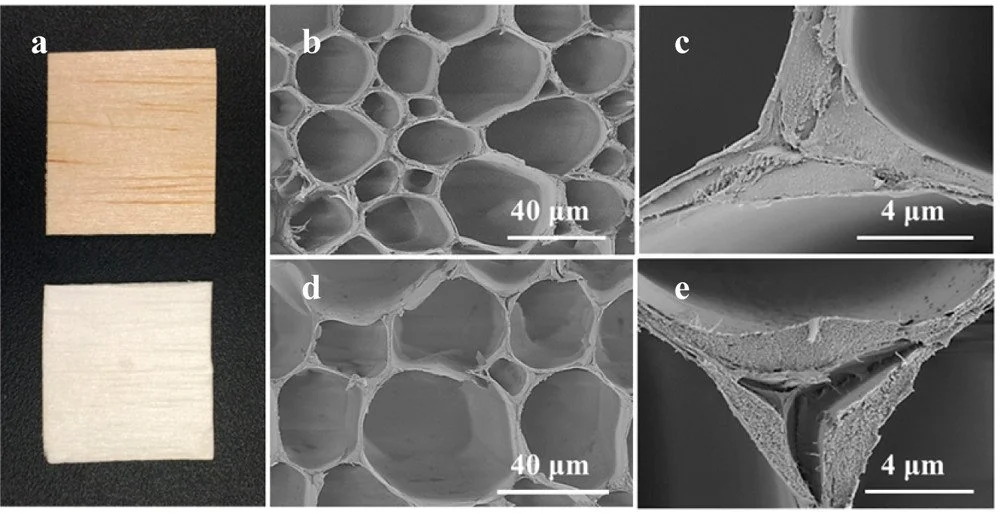From Forest to Facade: The Rise of Translucent Wood
Following on from the blog concerning glass bricks, this blog will consider an alternative source of light: translucent timber, a material that can combine the hardiness of wood with the transparency of a glass like surface. Transparent wood is an extremely new material with promising potential and growing interest within the architectural community. Despite little research being done in the past since its discovery in 1992 by Siegfried Fink, development for the materials testing has been increasing. In comparison to glass bricks, translucent timber offers several greater benefits, these include being sustainable, as timber is a renewable resource; being energy efficient, as this has the potential to be a greater thermal insulator; having greater impact resistance than glass, creating a safer atmosphere in certain environments where glass bricks can be too brittle. Along with these outstanding properties, functionally translucent timber can also be easier to transport in nature due to it being less likely to shatter and being a much lighter material. As is said by Yuanyuan Li et al: “Wood is of low density due to its polymeric origin and hollow cells functioning as liquid transport channels.”
Figure 1: Delignification of wood: (a) an optical image of wood before (up) and after (down) delignification. Low magnification (b, c) images of original wood (OW) cross section showing the micro structure of wood. Low magnification (d, e) images of delignified wood (DLW) cross section supporting the presence of a well-preserved wood structure. (Li, Y., Fu, Q., Yu, S., Yan, M., & Berglund, L. (2016). Optically Transparent Wood from a Nanoporous Cellulosic Template: Combining Functional and Structural Performance. Biomacromolecules.
Despite these unique beneficial characteristics, there are currently a few drawbacks to translucent timber from becoming viable in the real world for the time being. These include its economic viability: being a newly researched material, production is small scale making the material expensive and commercially fruitless. Along with this, translucent wood is not yet completely comparable to glass having up to 90% the light transmittance. The main current downside sticking out like a sore thumb, is the inclusion of fossil-based polymers replacing the removed lignin in from timber (lignin is the component of wood providing the colour).
However, the future of translucent timber is looking promising, it provides an auspicious alternative of light bringing with the potential of reducing Co2 emissions, this is explained by Yuanyuan Li et al, (2016) who states: Energy consumption in the building sector (including electric light, air conditioning, refrigeration, water heating, etc.) accounts for about 30–40%” This is a very high statistic, considering that many aspects of energy consumption can be easily minimised most obviously by switching off lights or designing structures that don’t require air conditioning. To combat this, Yuanyuan’s point is exemplified in ‘Optically Transparent Wood: Recent Progress, Opportunities, and Challenges’ which writes:”Most functional materials do not have load-bearing properties or are suitable for large-scale structures. Transparent building structure is one demonstration, where light transmittance can be designed so that artificial light can be partially replaced by sunlight. “
Figure 2: Scheme showing transparent wood preparation by a delignification approach. Scale bars in the scanning electron microscopy (SEM) images are 40 µm., American Chemical Society; Copyright 2017, Wiley-VCH
To conclude, I think a great brief of translucent timber can be taken from Futures Platform, which summarises “Transparent wood can create completely new markets for the wood industry, and its applications replace materials used in several fields. Best of all, it can mean that we can have bio-based alternatives for current materials created from non-renewable sources.”
Ultimately the future of translucent wood is uncertain, however the development for the material is promising and with the rapidly deteriorating planet, pressure for sustainable, renewable material shall likely increase, invention shall expand therefore accelerating development.
References
Fink, S. (1992). Transparent Wood – A New Approach in the Functional Study of Wood Structure. Holzforschung, 46(5), 403–408. https://doi.org/10.1515/hfsg.1992.46.5.403
Li, Y., Fu, Q., Yu, S., Yan, M., & Berglund, L. (2016). Optically Transparent Wood from a Nanoporous Cellulosic Template: Combining Functional and Structural Performance. Biomacromolecules, 17(4), 1358–1364. https://doi.org/10.1021/acs.biomac.6b00145
Li, Y., Vasileva, E., Sychugov, I., Popov, S., & Berglund, L. (2018). Optically Transparent Wood: Recent Progress, Opportunities, and Challenges. Advanced Optical Materials, 6(14), 1800059. https://doi.org/10.1002/adom.201800059
Maki-Teeri. M. (2017, June 21). Transparent Wood: Revolutions Ahead in Archiecture and Electronics. Futures Platform. https://www.futuresplatform.com/blog/transparent-wood
DIY Transparent Wood - Overview, Recipe, and Examples

